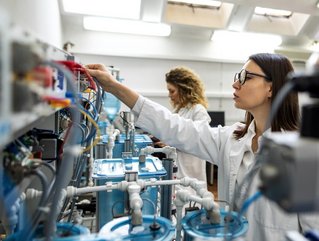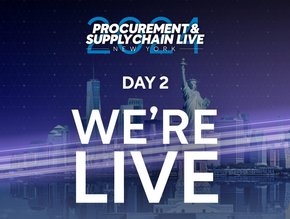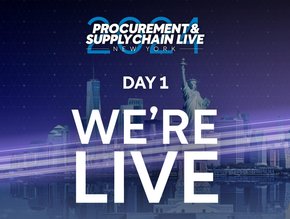Supply chain needs more women in STEM roles

Years ago, a distraught Alice Williams – an aspiring Royal Air Force member – was told, “You're too short to be a pilot”, before it was added that she “didn’t weigh enough”.
Williams – now VP of US Services Excellence at Schneider Electric – says that having her pilot dreams dashed was her “first experience of feeling like the world was not designed for me”.
Not one to be deterred, however, she instead pursued a career as an engineer in the British Army, maintaining tanks, among other things.
“I had to drive them,” she says. “But I’m only five-foot-one so I’d have to take the backrest off the seat and sit on it so I could see out to drive.”
Such situations, says Williams, are exactly why women remain far less likely to fill STEM roles in military and civilian life than men – with STEM being the umbrella term used to group together the technical disciplines of science, technology, engineering, and mathematics.
STEM supply jobs still mostly filled by men
Some progress is being made on attracting women into STEM roles in computer science, engineering, economics, and physics, yet these areas remain disproportionately male.
Being such a process-heavy discipline, supply chain has always had a strong STEM contingent. The discipline has long been a magnet for engineers of all descriptions, and the more senior the role, the likelier it is that the executive has a STEM background.
For example, of the top three women in our Top 100 Women in Supply Chain 2022 publication, only one – second-placed Francesca DeBiase, CSCO of McDonalds – lacks a STEM background, having instead read business administration at university.
Third-placed Mary Beth Lang – Chief Supply Chain Officer (CSCO) of managed-care company Kaiser Permanente – has a pharmacy degree and a PhD in information systems, while top-placed Carol Tomé, CEO of UPS, studied finance, which many hold to be an honorary STEM subject.
At Schneider Electric, which specialises in digital automation and energy management, Alice Williams helps ensure excellence in functions including logistics & supply chain, project management, and health & safety. It is a hugely technical role and demands that Williams draws on her nine years of military experience, which, aside from engineering, includes deep knowledge of operations and logistics.
Urgent need to redress STEM imbalance
At no point, says Williams, was she dissuaded or deflected from her STEM-dependent career goals.
In front of a both live and remote audience at BizClik’s TECH LIVE London event in June 2022, Williams delivered a keynote, ‘Recrafting the STEM narrative’, in which she explained why not enough is being done to redress the gender imbalance in STEM roles, including those in supply chain.
“When we design, build, and develop technology it has to represent the needs of the entire population, and just a certain percentage of it,” she said.
Such as fighter planes and tanks with female-friendly ergonomics, for starters. Williams stressed that challenges for women in the workplace go way beyond STEM inclusivity – that deep-seated workplace and societal biases need addressing.
“When Google and Apple launched their voice activation tech, both had a preference for male voices,” she says. “They would pick up questions from men more strongly than from women.”
She also points out that ambient office temperatures are nearly always geared to suit the male metabolism, which is why many women find office environments too cold. Such revelations are startling, but Williams feels the most-needed changes are societal.
“It’s all about narratives,” she says. “I only have sisters, my mum is a great professional role model and I went to an all-girls school, and at no point did anyone tell me there were things I couldn't achieve.”
She adds: “Our narratives around women and girls, and what they contribute to society, are vitally important, yet often these are not positive in nature.”
Positive narratives key to female STEM jobs
Williams talks of a “narrative gap” that needs bridging, so that girls’ STEM ambitions are not stymied and women’s STEM goals are accommodated on a physical, psychological, and emotional level in the workplace.
She points out that, with so many organisations digitally transforming themselves in the bid for greater resilience, there has never been a better – or more important – time to begin changing attitudes and practices around STEM inclusivity.
“More people than ever are re-skilling and retraining, and we must keep that narrative open for women at all stages of their careers so that anything is possible for anybody.”
She feels the career narrative for girls has improved dramatically in recent times, “in terms of encouraging them to believe anything is possible”.
But she says mid-career women looking to retrain or upskill are not finding ways into the STEM roles many desire.
“It's a really important area,” says Williams. “Women represent half of the world's population, yet there's an estimated US$1tn of female potential that is untapped because they are not engaged in the workforce, or ARE engaged, but in sectors that are not contributing as highly.”
Sectors such as supply chain.
“I learned very quickly in the Army that I could use the principles of engineering to do whatever I wanted to do. I realised I was really good at taking complex components, building them into systems and understanding how they added value to a situation.
Engineering is a mindset, not just a word
“I don’t pigeonhole myself as an engineer. The word ‘engineering’ is itself not particularly welcoming for women. Engineering is a mindset. It's about using transferable skills and combining these skills with creative thinking.”
Williams believes that, if engineering was sold as being a discipline that is about “adding value by getting maximum outcomes from minimum requirements”, then far more women would be attracted into STEM careers such as supply chain.
In addition, Williams feels that organisations need to be more open-minded about people’s – and not just women’s – existing skillsets when looking to fill STEM roles, particularly in AI and ML, which are huge growth areas for supply chain, procurement, and logistics.
“If you're looking for someone who can distil complex information and find the value-add, then editors and editorial writers are excellent at that. We need to begin looking






